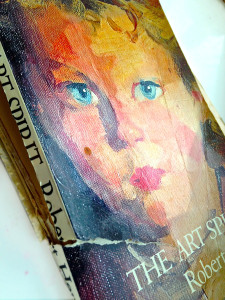
I’ve been re-reading The Art Spirit, by Robert Henri.
My dad brought the book over from the States when he and Mum came over to visit in 2007. The copy is a brown-paged paperback, now with a torn cover and shot binding, the pages no longer hanging together.
It’s one of the best books to and for artists I’ve read. For example:
“If you have the idea that an artist is not a decidedly practical person, get over it.”
Robert Henri (pronounced HEN-RYE) was a prominent voice in New York’s “Ashcan” School of realist painting in the 1920’s and a teacher at the legendary Art Students League of New York. He died in 1929, leaving a legacy of dedication to craft and honesty that saturated American painting in the 20th century. You can view the complete collection of his paintings here.
The Art Spirit addresses itself primarily to painters. Painters have much to teach writers. Just as writers have much to teach dancers. And dancers much to teach cartoonists. And cartoonists gardeners. And gardeners mathematicians, etc.

Artists, no matter what their gang affiliation, are all in the same classroom. The separation of disciplines is just window dressing. The essentials of making art – the underlying spiritual principles – whether in a bonsai or a ballet, are universal and mature artists borrow methods from other disciplines as easily as enlightened masters borrow from each other’s spiritual practices. It’s only fundamentalists who see a division between music and filmmaking, writing and painting, fencing and calligraphy. I’m not against fundamentalists. Fundamentalists are great for copywriting and branding – and some fundamentalists get rich, you know. But the artist is the one who, when he hears Robert Feynman talk about physics, suddenly understands how to solve that problem with his protagonist in the second act.
I’ve tended to be a screenwriter. I’m stained to the bone in movie-thinking. When Henri talks about “pictures”, I think “moving pictures” and I find his words apply effortlessly well to movies as to canvas. But they are also pointers toward the artistic life, an artist-way of thinking and working with the world. The canvas becomes the world, the world becomes the canvas.
If you’re a painter, illustrator, draftsman, sculptress, The Art Spirit will be of obvious help.
But if you’re an actor, a singer, an editor, a therapist, a matador, it may speak to your process just as directly. If it does, then maybe you and I are friends.
If you’re the Amazon type, you can buy the book here.

“When a drawing is tiresome. It may be that the motive is not worth the effort.”
“Art is certainly not a pursuit for anyone who wants to make money. There are ever so many other better ways.”
“It is not easy to know what you like. Most people fool themselves their entire lives through about this.”
“Don’t worry about your originality. You couldn’t get rid of it even if you wanted to. It will stick with you and show up for better or worse in spite of all you or anyone else can do.”
“Technique must be solid, positive, but elastic, must not fall into formula, must adapt itself to the idea. And for each new idea there must be new invention special to the expression of that idea and no other.”
“You can’t know too much about composition. That is; the areas you have to fill, their possibilities. But you must, above all, preserve your intense interest in life.”
“When the artist is alive in any person, whatever his kind of work may be, he becomes an inventive, searching, daring, self-expressive creature. He becomes interesting to other people. He disturbs, upsets, enlightens, and opens ways for better understanding. Where those who are not artists are trying to close the book, he opens it and shows there are still more pages possible.”
